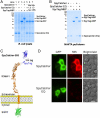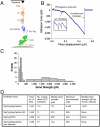Peptide tag forming a rapid covalent bond to a protein, through engineering a bacterial adhesin
- PMID: 22366317
- PMCID: PMC3311370
- DOI: 10.1073/pnas.1115485109
Peptide tag forming a rapid covalent bond to a protein, through engineering a bacterial adhesin
Abstract
Protein interactions with peptides generally have low thermodynamic and mechanical stability. Streptococcus pyogenes fibronectin-binding protein FbaB contains a domain with a spontaneous isopeptide bond between Lys and Asp. By splitting this domain and rational engineering of the fragments, we obtained a peptide (SpyTag) which formed an amide bond to its protein partner (SpyCatcher) in minutes. Reaction occurred in high yield simply upon mixing and amidst diverse conditions of pH, temperature, and buffer. SpyTag could be fused at either terminus or internally and reacted specifically at the mammalian cell surface. Peptide binding was not reversed by boiling or competing peptide. Single-molecule dynamic force spectroscopy showed that SpyTag did not separate from SpyCatcher until the force exceeded 1 nN, where covalent bonds snap. The robust reaction conditions and irreversible linkage of SpyTag shed light on spontaneous isopeptide bond formation and should provide a targetable lock in cells and a stable module for new protein architectures.
Conflict of interest statement
Conflict of interest statement: M.H. and B.Z. are authors on a patent application regarding peptide targeting via spontaneous amide bond formation (United Kingdom Patent Application No. 1002362.0).
Figures






Similar articles
-
Structural analysis and optimization of the covalent association between SpyCatcher and a peptide Tag.J Mol Biol. 2014 Jan 23;426(2):309-17. doi: 10.1016/j.jmb.2013.10.021. Epub 2013 Oct 23. J Mol Biol. 2014. PMID: 24161952 Free PMC article.
-
Catching a SPY: Using the SpyCatcher-SpyTag and Related Systems for Labeling and Localizing Bacterial Proteins.Int J Mol Sci. 2019 Apr 30;20(9):2129. doi: 10.3390/ijms20092129. Int J Mol Sci. 2019. PMID: 31052154 Free PMC article. Review.
-
SpyTag Peptide with Alkoxyl Aspartic Acids for pH-Dependent Activation of the SpyCatcher/Tag System.Bioconjug Chem. 2024 May 15;35(5):616-622. doi: 10.1021/acs.bioconjchem.4c00052. Epub 2024 Apr 25. Bioconjug Chem. 2024. PMID: 38664897
-
Isopeptide bonds block the mechanical extension of pili in pathogenic Streptococcus pyogenes.J Biol Chem. 2010 Apr 9;285(15):11235-42. doi: 10.1074/jbc.M110.102962. Epub 2010 Feb 5. J Biol Chem. 2010. PMID: 20139067 Free PMC article.
-
Superglue from bacteria: unbreakable bridges for protein nanotechnology.Trends Biotechnol. 2014 Oct;32(10):506-12. doi: 10.1016/j.tibtech.2014.08.001. Epub 2014 Aug 26. Trends Biotechnol. 2014. PMID: 25168413 Free PMC article. Review.
Cited by
-
Controlled labelling of tracer antibodies for time-resolved fluorescence-based immunoassays.Sci Rep. 2024 Aug 5;14(1):18113. doi: 10.1038/s41598-024-69294-7. Sci Rep. 2024. PMID: 39103434 Free PMC article.
-
Virus-Like Particle Vaccines Against Respiratory Viruses and Protozoan Parasites.Curr Top Microbiol Immunol. 2021;433:77-106. doi: 10.1007/82_2021_232. Curr Top Microbiol Immunol. 2021. PMID: 33650036 Review.
-
Design and characterization of a nanopore-coupled polymerase for single-molecule DNA sequencing by synthesis on an electrode array.Proc Natl Acad Sci U S A. 2016 Nov 1;113(44):E6749-E6756. doi: 10.1073/pnas.1608271113. Epub 2016 Oct 11. Proc Natl Acad Sci U S A. 2016. PMID: 27729524 Free PMC article.
-
A single domain antibody-based Luminex assay for the detection of SARS-CoV-2 in clinical samples.Front Immunol. 2024 Aug 13;15:1446095. doi: 10.3389/fimmu.2024.1446095. eCollection 2024. Front Immunol. 2024. PMID: 39192985 Free PMC article.
-
Antibody Drug Conjugates for Cancer Therapy: From Metallodrugs to Nature-Inspired Payloads.Int J Mol Sci. 2024 Aug 8;25(16):8651. doi: 10.3390/ijms25168651. Int J Mol Sci. 2024. PMID: 39201338 Free PMC article. Review.
References
-
- Jarvik JW, Telmer CA. Epitope tagging. Annu Rev Genet. 1998;32:601–618. - PubMed
-
- Griffin BA, Adams SR, Tsien RY. Specific covalent labeling of recombinant protein molecules inside live cells. Science. 1998;281:269–272. - PubMed
-
- Allen KN, Imperiali B. Lanthanide-tagged proteins--an illuminating partnership. Curr Opin Chem Biol. 2010;14:247–254. - PubMed
-
- Huh WK, et al. Global analysis of protein localization in budding yeast. Nature. 2003;425:686–691. - PubMed
Publication types
MeSH terms
Substances
Associated data
- Actions
Grants and funding
LinkOut - more resources
Full Text Sources
Other Literature Sources
Research Materials

